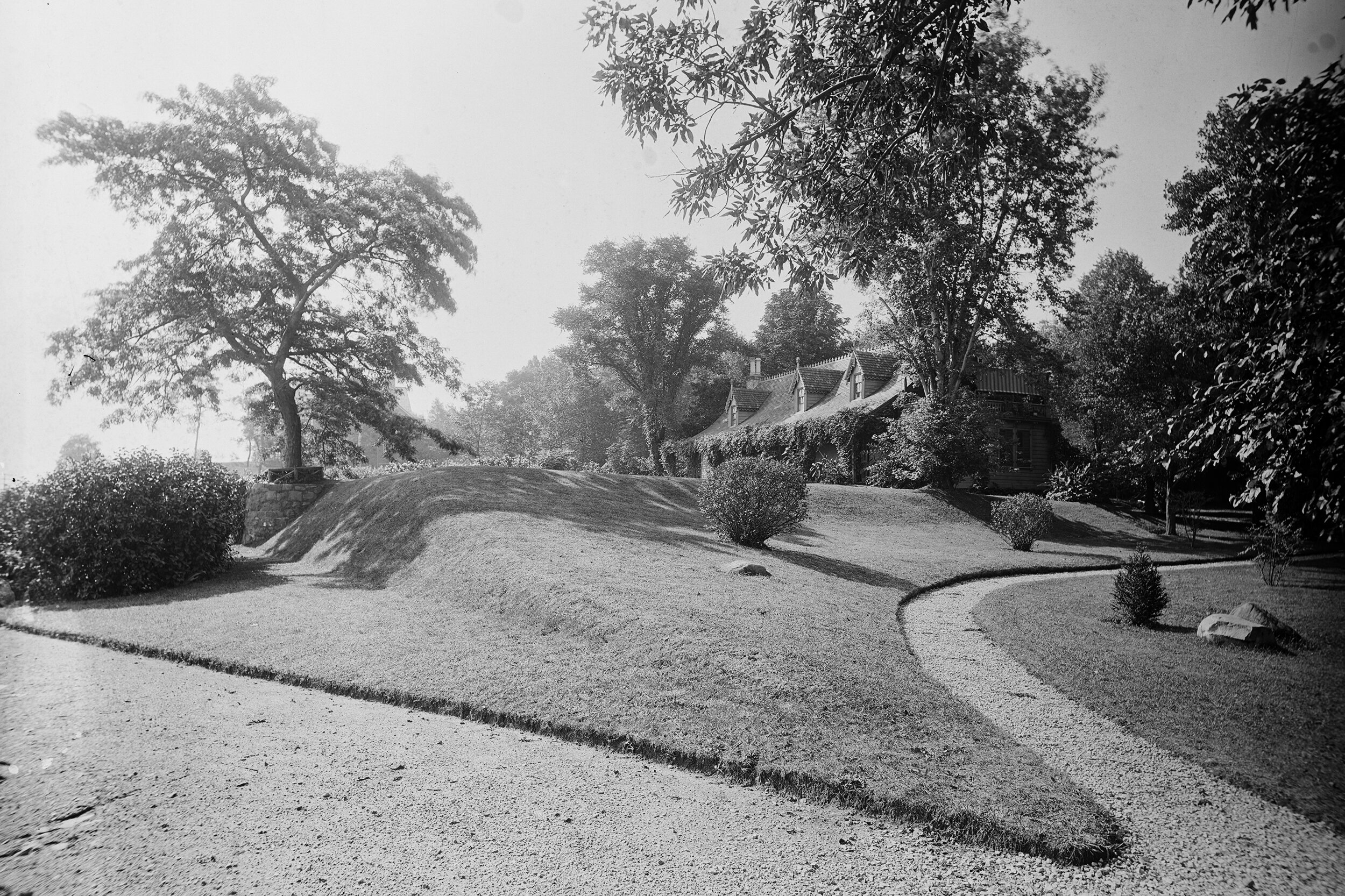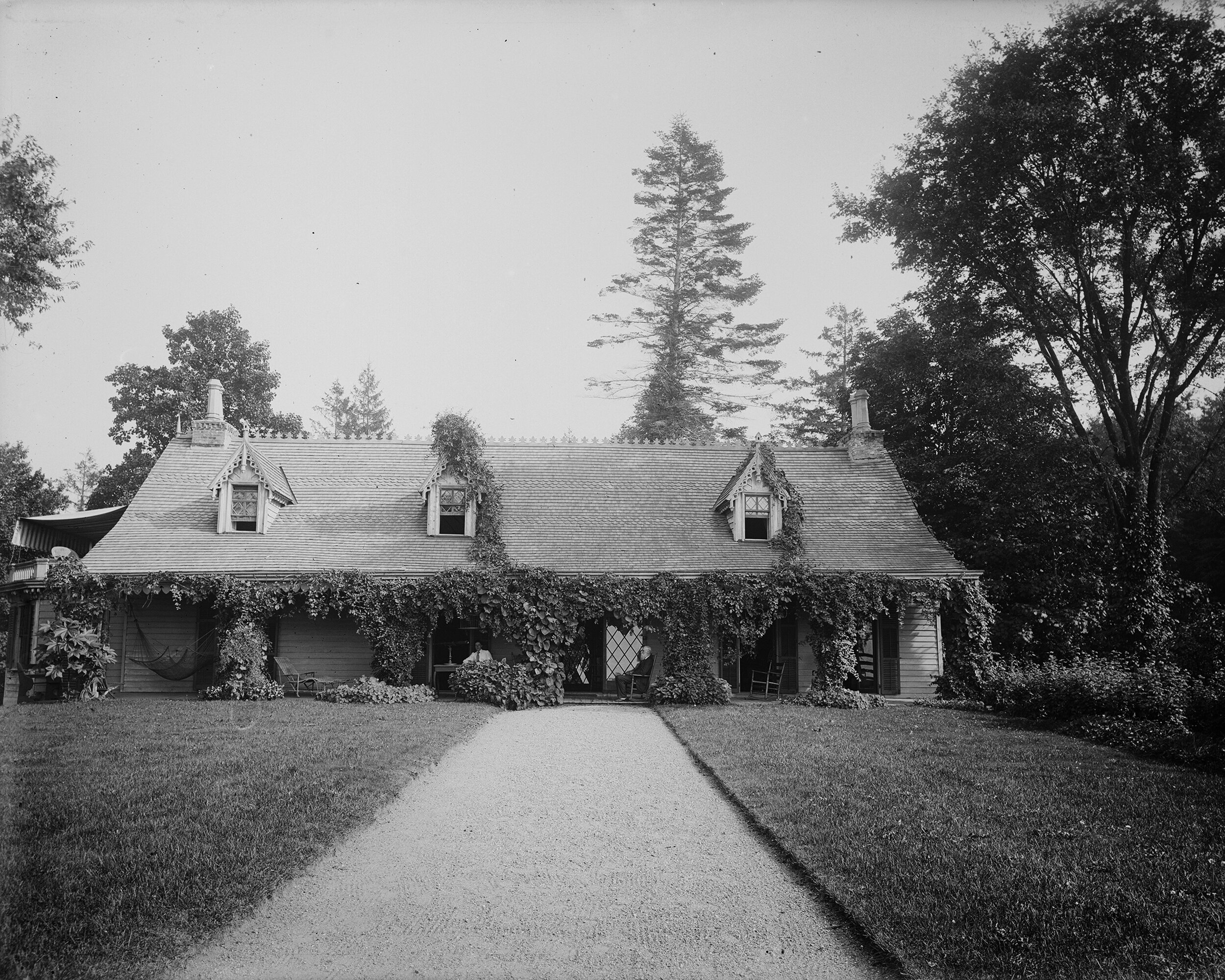Alice Austen: Suburban Staten Island and Clear Comfort
Miss Alice Austen and Staten Island’s Gilded Age
by Bonnie Yochelson
Suburban Staten Island and Clear Comfort
From childhood to old age, Alice Austen lived at Clear Comfort, her grandparents’ Victorian cottage that faced the Narrows, where New York Harbor meets the Atlantic Ocean.
By the 1830s, the explosive population growth in lower Manhattan and the ease of steamboat travel combined to offer city dwellers a bit of countryside only thirty minutes away on Staten Island. Alice’s grandparents began spending summers there, and in 1844, they purchased waterfront property in the neighborhood of Clifton, near the Narrows where New York Harbor meets the Atlantic Ocean.
James Bornet, Panorama of the Harbor of New York, 1854. New York Public Library, Digital Collections
Alice Austen’s life – from 1866 to 1952 – spanned the rise and fall of Staten Island high society. During the post-Civil War boom, the families of Staten Island industrialists and stockbrokers competed with Manhattan’s nouveaux riches for displays of extravagant wealth. Alice held her own among this set without the benefit of a great fortune. She was a popular member of the Island’s elite, whose life of leisure she captured with her camera. By the turn of the 20th century, factories and working-class families began to surround her family’s home, and socially ambitious families moved away to Westchester County, Long Island and New Jersey.
Alice Austen’s Staten Island
G.W. & C.B. Colton & Co., Map of Staten Island, 1889. New York Public Library, Digital Collections
1 Miss Errington's School; 2 Woodbine Cottage; 3 Clifton Boat Club; 4 Former Bredt family house; 5 Clear Comfort; 6 Julie Marsh Lord's house; 7 Quarantine Station; 8 St. John's Episcopal Church and rectory; 9 Marsh family house; 10 Fort Wadsworth; 11 Clifton Tennis Club; 12 Martin family house; 13 South Beach; 14 Ward family house; 15 Perine House; 16 Richmond County Country Club; 17 New York City Farm Colony; 18 Staten Island Cricket and Baseball Club/Staten Island Ladies' Club; 19 Wisteria Apartments; 20 Staten Island Bicycle Club
Alice’s grandfather, John Haggerty Austen, was a successful auctioneer in Manhattan. After moving his wife and children to Staten Island, he restored and expanded an old Colonial farmhouse into a Victorian cottage, embellishing it with Gothic Revival decorative woodwork and designing gardens and winding paths in the picturesque style of the day.
[Alice Austen and Elizabeth Alice Townsend Austen], July 1885. Collection of Historic Richmond Town, 50.015.2338
His wife, Elizabeth Townsend Austen, named their home Clear Comfort, and it became Alice’s sanctuary. She photographed Clear Comfort throughout her life, and her photographs, which presented an edenic vision of a bygone era, helped save the house from demolition in the 1970s. The Alice Austen House is now a museum and National Historic LGBTQ Site.
Alice Austen was named “Elizabeth Alice” after her grandmother. The photograph (at right) of Alice with her grandmother on the piazza of Clear Comfort is dated July 1885 and is one of Alice’s earliest images. Her grandmother died two years later at the age of 74.
Alice’s most celebrated ancestor was Peter Townsend—her grandmother’s grandfather—who was a Revolutionary War hero. In 1778, Townsend’s Sterling Iron Works manufactured the massive “Great Chain” that spanned the Hudson River at West Point and kept the British fleet from traveling farther north. A link from the Great Chain, an Austen family prized possession, was prominently displayed over the parlor fireplace (below).
Parlor at home, fireplace, November 14, 1888. Collection of Historic Richmond Town, 50.015.6505
When Alice photographed her grandfather, John Haggerty Austen, in 1891, he was 81 years old but still taking the ferry to his Manhattan office and climbing ladders to tend to the decorative vines covering the Clear Comfort piazza. He died in 1894.
Grandpa on ladder, May 4, 1891. Collection of Historic Richmond Town, 50.015.5418
[Alice Cornell Austen at Clear Comfort], ca. 1892-1896. Collection of Historic Richmond Town, 50.015.5428
Alice took this photograph of her mother, Alice Cornell Austen, when her mother was in her late fifties. Plagued by ill health, Alice’s mother died in 1900 at the age of 62.
Alice’s parents, Alice Cornell Austen and Edward Stopford Munn, married in 1863 and lived in a house known as Woodbine Cottage, a few blocks away from Clear Comfort. Shortly after Alice was born in 1866, her parents separated, and Alice’s mother moved home and reclaimed her maiden name. For reasons unknown, the Austen family alleged that Munn had abandoned his wife and child to return to his native England, but Munn lived in Brooklyn until his death in 1879 at the age of 52. The couple never divorced.
Our room beds, November 28, 1898. Collection of Historic Richmond Town, 50.015.5256
Alice and her mother shared a room on the first floor of Clear Comfort, and their relationship was as close as their small, crowded room would suggest. Mama’s letters to Alice are filled with local gossip, shopping reports, maternal fretting—“You poor child to go in for rowing and tennis at once, please don’t work too hard”—and encouragement—“You certainly have accomplished a great deal . . . surely you are intended to succeed in life, and see the world.”
Our three servants, Katie, Hannah and Mary, November 23, 1890. Collection of Historic Richmond Town, 50.015.6645
The Austens’ servants were Irish, Scottish or German immigrants. Relying on a wood-burning stove, gas lamps and well water, they cooked, did laundry, and cleaned the house, which although small, was filled chock-a-block with dust-gathering objects. Katie (right) was especially devoted to the family’s pets. The servants slept in two small attic rooms in close quarters with family members.
The Austens’ dogs—Punch, a pug, and Chico, a Chihuahua—often appear in Alice’s photographs, but here, at bath time, they take center stage. They were full-fledged family members, as Mama Austen’s letters to Alice demonstrate. In 1890, she wrote, “Punch misses you. . . [He] burst through one of the middle room panes, shivering it to pieces, the piazza was covered with glass, he strolled out unhurt.”
Dogs in wash tub, August 6, 1887. Collection of Historic Richmond Town, 50.015.6682
This photograph of Alice with her Aunt Minn (Mary Haggerty Austen) and Minn’s second husband, the Danish-born sea captain Oswald Muller, was taken by Oswald, who taught Alice the rudiments of photography. Alice’s earliest dated photograph is 1884, and there are a series of family portraits taken around that date that may represent his camera lessons. Although Alice later claimed she had learned to use the camera as a young child, it is more likely that she began to photograph in 1884, the year that Aunt Minn and Uncle Oswald moved to Clear Comfort after many years at sea.
[Aunt Minn, Uncle Oswald, and Alice Austen], ca. 1884-85. Collection of Historic Richmond Town, 50.015.2341
Minn and Oswald lived in an upstairs room to which they added an enclosed porch dubbed, “The Quarterdeck,” which could be entered by exterior stairs. The interior was filled with souvenirs from their many voyages.
[Clear Comfort quarter deck interior with fans], March 6, 1911. Collection of Historic Richmond Town, 50.015.0108
Auntie’s roof, sofa end, March 6, 1911. Collection of Historic Richmond Town, 50.015.0106
In November 1869, Minn and her first husband Samuel Hicks sailed from New York to Australia aboard the ship Agra, which was captained by Oswald Muller. In July 1870, on their return trip, Hicks died of consumption. In March 1871, Minn and Muller were married on Staten Island, and together they traveled to European, Asian and Australian ports for fourteen years.
[Clear Comfort exterior and grounds], n.d.. Collection of Historic Richmond Town, 50.015.6507




![[Clear Comfort exterior and grounds], 1891 Collection of Historic Richmond Town, 50.015.7001](https://images.squarespace-cdn.com/content/v1/5d23a00f53f6300001f811bb/1630202240329-52I21WPX733AFPU4KRZH/50.015.7001_aa_slide-2-c.jpg)
![[Woman watching steamship from Clear Comfort grounds], n.d. Collection of Historic Richmond Town, 50.015.5837](https://images.squarespace-cdn.com/content/v1/5d23a00f53f6300001f811bb/1630202268563-DPCPSCBAC6NFWKMRDTQJ/50.015.5837_aa_slide-3-c.jpg)
![[Alice Austen and Elizabeth Alice Townsend Austen], July 1885. Collection of Historic Richmond Town, 50.015.2338](https://images.squarespace-cdn.com/content/v1/5d23a00f53f6300001f811bb/1630202335149-LYYW924B1M4VWLJU8OZA/50.015.2338_aa_gray-c.jpg)


![[Alice Cornell Austen at Clear Comfort], ca. 1892-1896. Collection of Historic Richmond Town, 50.015.5428](https://images.squarespace-cdn.com/content/v1/5d23a00f53f6300001f811bb/1630202443126-OTVSDIH2JESL3NUKWCY6/50.015.5428_aa-c.jpg)



![[Aunt Minn, Uncle Oswald, and Alice Austen], ca. 1884-85. Collection of Historic Richmond Town, 50.015.2341](https://images.squarespace-cdn.com/content/v1/5d23a00f53f6300001f811bb/1630202503732-HOVRMGA6A9BR99KFOHPY/50.015.2341_aa_gray-c.jpg)


![[Clear Comfort exterior and grounds], n.d.. Collection of Historic Richmond Town, 50.015.6507](https://images.squarespace-cdn.com/content/v1/5d23a00f53f6300001f811bb/1633387623595-JWD83E6300KGP6FR52RF/50.015.6507_aa-c.jpg)